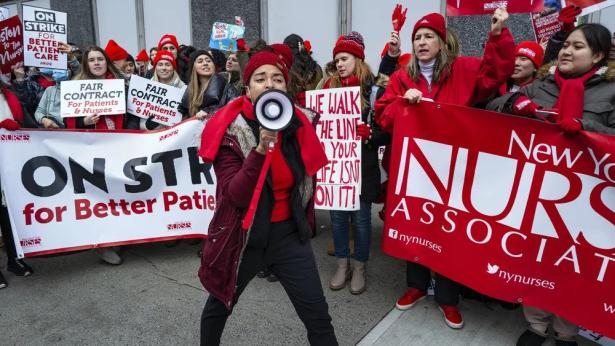On Monday, 7,000 New York nurses at Montefiore Medical Center in the Bronx and Mount Sinai Medical Center in Manhattan went on strike over massive short staffing.
While a Montefiore spokesperson said “the union leadership’s decision will spark fear” in the public, and a Mount Sinai representative called the strike “reckless,” the hospitals have understaffed while boosting executive pay and slashing charity care.
Nurses have faced extreme staff shortages since the COVID-19 pandemic began, with nurses in the emergency departments in New York City sometimes handling 20 patients at a time. That’s more than five times what is allowed by law in California, the only state with nurse-to patient-ratios enshrined in law. Such short staffing, say nurses, translates into poorer care for hospital patients.
“We’re not out here for ourselves, we are out here for our patients,” said Matt Allen, a union member-leader at Mount Sinai at a press conference Monday. “Our bosses created the understaffing crisis,” New York State Nurses Association President Nancy Hagans told Politico.
Hospitals received $175 billion in COVID-related aid during the pandemic, helping to boost profit margins — but little of that money trickled down to employees. At the end of September 2022, Montefiore was sitting on $1.3 billion in cash and investments, while Mount Sinai had $2.6 billion at the end of 2020.
The nurses’ union contracts with the hospitals expired at the end of last year. Labor negotiations for a new contract broke down due to the ongoing staffing crisis in the hospitals, as well as over demands for language mandating that minimum staffing levels are actually enforced.
Left out of all of corporate media’s current coverage of the strike is the enormous profits and hefty executive compensation packages enjoyed by the hospitals in question. While Montefiore and Mount Sinai are technically nonprofits, they frequently act like large corporations — with massive investments on Wall Street and overseas, and providers sidelined from essential care decision-making.
Montefiore reported $199 million invested in “limited partnerships” like hedge funds and private equity in 2020, according to tax filings reviewed by The Lever. Mount Sinai reported $68 million in investments in “Central America and the Caribbean.” Typically, investments in this region are in tax shelters like the Cayman Islands.
These nonprofit hospitals also boast huge executive salaries. Mount Sinai CEO Kenneth Davis made $5.6 million in 2019, the last year for which complete tax records are available. Montefiore CEO Philip Ozuah made $7.4 million in 2020. Montefiore disclosed providing an unnamed executive (or executives) with a chauffeur and first-class airfare in 2020.
In filings with the IRS, Mount Sinai disclosed that 15 executives made more than $1 million annually in 2019. Montefiore disclosed ten in 2020, with all making more than $1.5 million.
The 2017 Trump tax law mandated a 21 percent excise tax on all nonprofit compensation over $1 million annually, paid by the nonprofit themselves, which meant that these outsize salaries come with significant tax expenses, taking away essential resources from patient care.
In 2010, Montefiore paid $4 million to its then-CEO, meaning that the CEO of Montefiore has received an annualized increase in compensation of 8.5 percent from 2010 to 2020. Mount Sinai CEO Kenneth Davis made just $2.6 million in 2010, meaning that he received annualized raises of 12.8 percent from 2010 to 2019. In comparison, the wage increases that most nurses in the city have agreed to is 7 percent, 6 percent, and 5 percent for the three years of the new contract.
Meanwhile, Mount Sinai’s allocation to charity care as a percentage of its total expenses cratered by nearly 50 percent from 2010 until 2020, dropping from nearly 2 percent of total expenses to just over 1 percent, according to tax filings. Charity care provides free or discounted care to those in poverty, a key justification for the massive tax breaks nonprofit hospitals receive. Montefiore saw a less stark but still jarring 23 percent decline in charity care spending as a percentage of expenses from 2010 until 2020, from 1.4 percent to just over 1 percent.
Montefiore’s generosity towards its executives and stinginess with charity care is ironic in light of the fact that it depends far more on public dollars from Medicaid and Medicare than the average hospital, due to it being located in one of the poorest urban counties in America, the Bronx. For the nine months ending September 2022, more than two thirds of the system’s revenue came from Medicaid and Medicare, as opposed to one third for the average hospital. Mount Sinai earns a similar portion of its revenue from government programs because of systemic, ongoing poverty in New York City.
On Sunday, Democratic New York Governor Kathy Hochul called for labor and management to enter binding arbitration, rather than backing the nurses. The New York State Nurses Association stated in a press release that “Hochul should listen to frontline COVID nurse heroes and respect our federally-protected labor and collective bargaining rights.”
To fill an opening for Chief Judge of the New York State Court of Appeals, the state’s highest court, Hochul is currently seeking to install Hector LaSalle, who has backed rulings allowing bosses to sue union leaders. New York Attorney General Letitia James, a rival of Hochul’s who explored a primary challenge to the governor in 2022, joined nurses on the picket line at Mount Sinai in Manhattan Monday.
Some reports have indicated that replacement nurses are being offered as much as $9,800 per week to work at the hospitals during the strike.
==


Spread the word